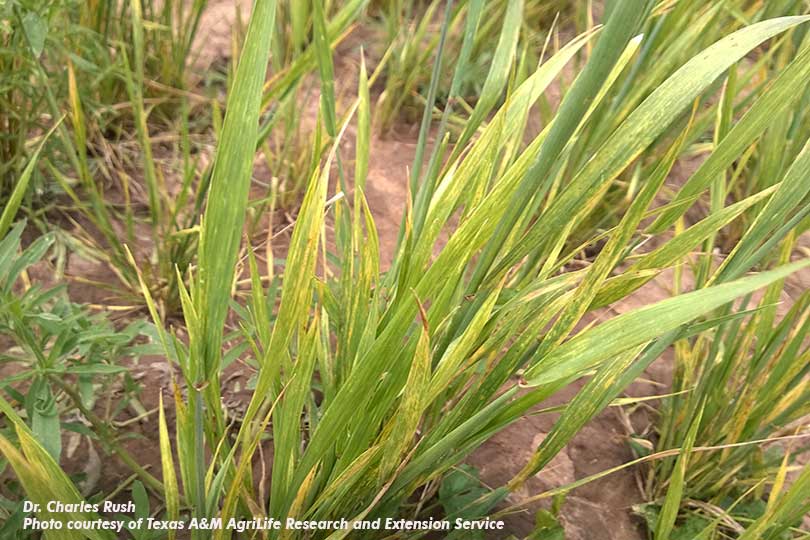By Shala Watson
Multimedia Writer
The Texas wheat crop faced another challenging year from reduced acreage, weather events and disease pressures. Wheat streak mosaic virus (WSMV) was one of the diseases that plagued the wheat crop.
WSMV was reported in the Blacklands region in March.
Texas A&M AgriLife Research Plant Pathologist Dr. Charles Rush, along with county Extension agents and crop consultants across the state, conducted a survey and collected wheat samples from most of the major wheat-producing counties in the Panhandle.
“Wheat streak and triticum (TriMV) were common and widespread in many fields we sampled,” Rush said.
Triticum mosaic virus is a related virus that also affects wheat yields.
Rush noted as of June 13, the data is still being tabulated.
Bernd Friebe, department of Plant Pathology Research professor at Kansas State University, is part of a team that recently identified Wsm3, a gene that provides resistance to WSMV.
Friebe said in a news release the gene is just the third gene known to provide resistance to the virus—and the first that can do so at outdoor temperatures of 75 degrees Fahrenheit and higher.
“We need more genetic diversity” for controlling wheat streak mosaic virus, Friebe said. “Leaf, stripe and stem rust each have about 70 named resistant genes. This is progress toward developing more resistance toward wheat streak mosaic virus.”
The virus causes stunting and yellowing of the leaves, which leads to yield losses. As temperatures increase, the symptoms get progressively worse.
WSMV is characterized by streaks of yellow non-uniform discoloration in wheat. Plants infected as seedlings are often stunted and have a reduced head size. The disease causes yield losses so severe that in extreme cases the crop can’t be harvested.
In the past, farmers’ efforts to control the virus have focused mostly on removing volunteer wheat. Volunteer wheat harbors the wheat curl mite, which is the primary carrier of WSMV.
The first two genes known to provide resistance to the virus were Wsm1, identified by Kansas State University about 25 years ago, and Wsm2, which was discovered by researchers at Colorado State University.
But those two genes only provide protection in lower temperatures. Friebe said the warm-weather friendly Wsm3 used in combination with Wsm1 or Wsm2 could become part of a breeding mix that can give farmers’ much needed relief.
The new WSm3 germplasm has been released through the Kansas Agricultural Experiment Station. It is currently available to breeders through the National Science Foundation’s Industry/University Cooperative Researcher Centers program. It will also be available to public breeding programs in two years.
Rush said his concern is that breeders are introducing resistance to WSMV but not always TriMV.
Friebe said both “Wsm1 and Wsm3, as a bonus, are also conferring resistance” to TriMV, but only at cooler temperatures.
Until newly-developed resistant varieties are available, growers are urged to continue with best practices for controlling the spread of WSMV in their fields. They include timely removal of volunteer wheat and grassy weeds, avoiding early planting and planting currently-available resistant varieties.
Wheat that is planted early—August and September—for fall grazing is especially susceptible to viral diseases as there has not been adequate time to break the “green bridge” between volunteer wheat that serves as a host for the wheat curl mite/viral diseases and the newly established wheat field.
For more information about WSMV, click here or visit kswheat.com/wheatstreak.

